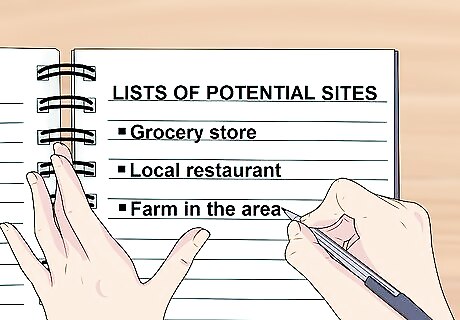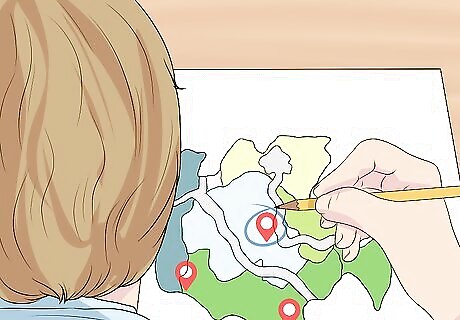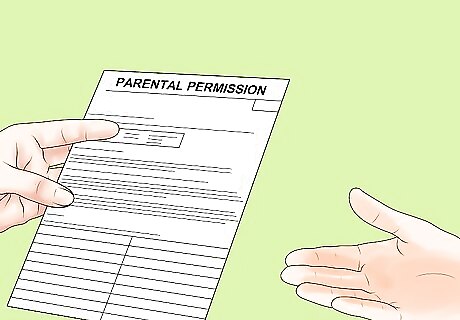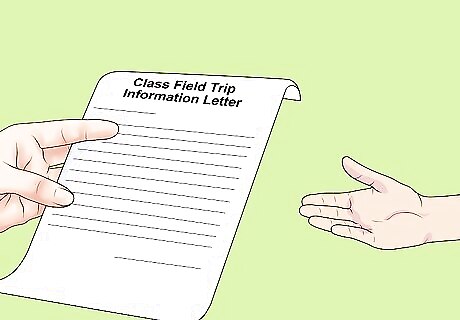
views
X
Research source
Selecting an Educational Site for a Field Trip

Talk with the principal of your school. Ensure that you’re able to plan a field trip or if what you want to do is possible. Explain the educational value and the relationship to the curriculum of the grade level(s) that will attend. You will also want to clarify a date with the principal in order to ensure that the class trip does not conflict with any other mandatory school activities. Ask about emergency protocols while you’re on the trip. Review the school’s guidelines so you can be prepared.

Determine the educational goals of the trip. The first thing that needs to be done when planning a class trip is to determine how the trip will support the educational curriculum of the course. Ask yourself “How will this trip enhance the classroom program?” For example, you will not get approval if you want to take a science class to a historic monument, despite the fact that a monument is educational. Consider the following: Learning outcomes of the trip. Key vocabulary that will be used and taught during the trip. Major concepts that will be taught. Can the learning objective be accomplished without a field trip?

Consider the age and learning abilities of your students. When selecting a destination for a field trip it is important to keep the class curriculum and learning objectives in mind. You should also consider the age and learning abilities of the students in your class. For instance, an overnight ropes course to learn cooperation is not suitable for students in the second grade. Young children will not be able to physically complete a ropes course and they are too young to attend an overnight trip.

Make a list of potential sites. Once you have clearly determined the learning objectives of the trip and assessed the age and learning abilities of the students in your class, make a list of potential field trip destinations. For example, if you are teaching an 8th-grade health class you could consider the following sites: Grocery store: Perform a nutritional scavenger hunt. Ask students to read food labels and create a weekly meal plan that would adequately meet their nutritional needs. Local restaurant: Learn to cook a nutritional and well-balanced meal at a local restaurant. Farm in the area: Visit a farm and learn how livestock are raised, fed, and distributed to customers.

Contact potential sites. Once you have created a list of potential sites for your field trip, you should contact them and learn more details about the programs and educational activities they offer. Some places will have pre-trip information packages that they can provide. It is also important to find out the available dates and times, and admission costs associated with each site You should also ask the site how many students they can accommodate. You want to make sure that they can handle the size of your group. Ask about areas for seating and how many restrooms there are. This additional information will help you to narrow down your list and ultimately select a site.

Choose an affordable destination. When deciding on a location for a class trip, you should take into consideration the cost of the trip. You want to make sure that it is not too expensive so that most students in your class will be able to attend. You do not want your students to miss out on an important learning activity because they can’t afford to attend a class trip. Here are a few suggestions to cut down costs: Choose a local site to cut down transportation costs. Find a site that allows students to bring their own food and snacks so they don’t need to spend money on lunch or food. Inquire if the site offers any discounted group or student rates. Determine if you need to plan an agenda while you’re there or if a tour will be provided.

Decide on a location. Choose a location that meets all of the criteria you have outlined throughout your selection process. The site should meet all learning objectives, provide appropriate activities for the age and learning abilities of your students, be able to accommodate the number of students in your class, and be reasonably priced. Once you have officially selected a destination, you should get the name, phone number, and email address for a contact person at the site. This will make it easier to book the trip, once you have received the necessary approval. If the trip will be over the course of multiple days, you will need to make appropriate overnight arrangements. Camping is an excellent way to provide students with a positive educational experience, but alternative indoor sleeping arrangements are frequently made as well. A tent campground with one or more group campsites, cabin, dormitory, sleeping hall, or hotel that accommodates three students per room would be most ideal for overnight school trips.
Obtaining Permissions for the Field Trip

Obtain permission from your school board. Speak with a representative from your school board in order to gain access to standardized letters for parental permission as well as the standard trip planning package. If your school board has a trip planning package you will need to fill out all of the forms included in the planning package in order to get permission from the superintendent. This will vary between school boards. Talk with the principal or a senior colleague to determine the exact requirements associated with taking a class on a field trip.

Gain parental permission for each student. Each parent will also need to fill out a permission form in order for their child to attend the class trip. Permission forms should be sent out well in advance of the trip date in order to give families time to read over the forms, pay any costs associated, and arrange their schedules accordingly. Things to include on a permission form are: Date and location of field trip as well as all transportation arrangements. Educational purpose of the field trip. Cost associated with the trip and date the money needs to be submitted. Information about meal arrangements. Trip schedule or list of activities for the day. Place for parental signature and contact information.

Ask parents to fill out medical release forms. If you are not travelling with an insurance company, you should ask parents to fill out a separate medical form which includes information regarding student health, medical insurance, and parental permission for medical treatment if required. Speak to your supervisor to determine what is required.Your school board may provide a standard form for medical releases or you can conduct an internet search for “medical release forms.”
Planning the Logistics of the Field Trip

Finalize your reservations for the group. Once you have received permission from the school and school board, you will need to finalize the reservation with the site. You will also need to be in touch with them again once you have final numbers after receiving all student permission forms.

Arrange for transportation to and from the field trip. Schools usually have different systems for organizing buses and transportation for field trips. You will either use an outside contractor or the regular school board buses. If you are using buses through the school board you will need to make sure that the field trip does not interfere with the bus driver’s regular scheduled route. Regardless of the type of bus you use, you will need to clearly communicate to the driver the proper addresses and times for pickup and drop off. You should also provide the number of people traveling, including chaperones and teachers. You should also introduce yourself as the class leader on the day of the trip and thank the bus driver for their work. Exchange numbers to stay in contact in case there are any changes on the day of the trip.

Conduct a pre-visit to the site. Most field trip venues will allow teachers to visit the site in advance free of charge. This will allow you to familiarize yourself with the site and scheduled activities, meet the staff, and learn where the washrooms are located. You may also want to take pictures of some of the exhibits to show to your students prior the field trip. Explore some of the exhibits and activities that your class will be visiting in order to come up with ideas for pre-trip classroom activities.

Recruit chaperones. Depending on the size of your class and the requirements of the venue you may need to ask for volunteer chaperones. Parents or family members of your students make great chaperones. You may also be able to ask a colleague or administrator at the school to help out with chaperoning duties. Once you have acquired enough adult chaperones, you should provide them with any behavioural guidelines and a detailed schedule for the trip. Do not assume that adults will intuitively know what is expected of them. Schedule a meeting with the chaperones before the trip to explain their roles, responsibilities, and any emergency protocols. If there are too many volunteers for chaperones, use a lottery system to select the number you need. If you have too few, reach out to parents or the school’s PTA. Ask chaperones to carry a cell phone so you can easily contact them on the day of the trip.

Compile all of the necessary paperwork into a single binder or database. Throughout the planning process you have likely accumulated a large amount of paperwork that you may need to access on the day of the trip. Compile the following forms and information into a single binder or store it electronically on your tablet or cellphone: Signed permission forms. Student medical and insurance information. Parent/guardian emergency contact information for that day. Extra money in case of an emergency. Checklist of all students and chaperones in attendance. List of students who must take medication during the trip

Take careful attendance on the day of the trip. You will need to have a clear idea of exactly who is attending the field trip and you will also need to communicate this information to the following people: The school office: Provide a list all of the children attending the trip, the children absent that day, the children who will remain at the school and their location, and a cell phone number where you can be reached. Chaperones: Provide a comprehensive class list, a list of each subgroup, and the name of the supervisor for each group. Teachers: Provide a master list of all the groups, all the buddy partnerships, the parent contact information, the student health and insurance information, and the school phone number. Have attendance sheets ready so the staff can take head counts during the trip.

Make alternate arrangements for the students who do not go on the trip. Ideally, all children in the class will attend the trip because it is part of the instructional day. However, some students will not be able to attend, for various reasons. Make sure that you provide these students with fun activities to engage in while they remain at school. If possible try and provide them with a similar experience. For example, you could have them complete an online scavenger hunt by researching a similar topic to that being covered on the class trip. Be creative and try and come up with a fun activity for these students.
Preparing Your Students for a Field Trip

Integrate the trip into classroom lessons. Studies have shown that students who receive pre-trip instructions and lessons learn and retain more from the trip than those who had no pre-trip preparation. For example, if you are doing a unit on animal habitats and are going to visit a zoo at the end of the unit, you may want to begin by learning about different ecosystems and habitats in the classroom: Have your students study the habitats of a variety of animals they will see at the zoo. Then ask them to record the features of the habitats that the zoo provides for the same animals. Have them compare the natural habitats to the constructed zoo habitats to see if they are getting a similar type of lifestyle.

Explain all activities prior to the trip. Prepare your students for the field trip by explaining to them the activities they will be expected to perform throughout the day. Going over a detailed schedule in advance will allow students time to prepare. This will also give you the opportunity to provide any instructions, which will save time on the day of the trip. You could also brainstorm questions that the class may want to ask of the instructors at the site. Alternately, you could teach your students how to ask thoughtful questions.

Communicate behavioural expectations. Discuss all behavioural expectations prior to the trip as well as any and all consequences that students will face if they misbehave. For example, if you are attending a museum you may want to remind students to be quiet, respectful, and avoid touching any of the museum artifacts. Failure to do so, may result in a call home to their parents. By outlining your expectations clearly, you will likely run into less problems on the day. Outline expected behaviour during transit as well. For example, students must remain seated while on the bus and should not distract the bus driver.

Discuss safety with your class. Regardless of the type of trip you are taking you should always clearly outline certain safety precautions in advance. For example, if you are taking a group of young students on a field trip, you should go over traffic safety beforehand. Depending on the type of trip you may want to establish a buddy system or seating plan for safety purposes. You could also divide the class into smaller groups with adult supervisors and chaperones. This will make it easier to monitor student behaviour.

Send a letter home providing students with additional information about the trip. Aside from the permission and medical forms, you should also give students more detailed information about the schedule and what they should take with them on the trip. For example, you can include: The destination, with a physical description of the site. Detailed list of the planned activities. Any special preparations the parents and students need to make for that day, such as special clothing, boots, lunches, money, sunscreen, gloves, backpacks, water bottles, etc. The drop off and pick up time for the children, if it differs from the regular school day. A packing checklist if the trip involves overnight travel.




















Comments
0 comment